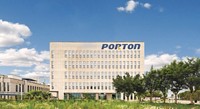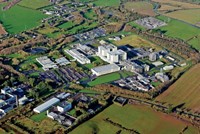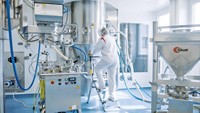Advertisement
Grab your lab coat. Let's get started
Welcome!
Welcome!
Create an account below to get 6 C&EN articles per month, receive newsletters and more - all free.
It seems this is your first time logging in online. Please enter the following information to continue.
As an ACS member you automatically get access to this site. All we need is few more details to create your reading experience.
Not you? Sign in with a different account.
Not you? Sign in with a different account.
ERROR 1
ERROR 1
ERROR 2
ERROR 2
ERROR 2
ERROR 2
ERROR 2
Password and Confirm password must match.
If you have an ACS member number, please enter it here so we can link this account to your membership. (optional)
ERROR 2
ACS values your privacy. By submitting your information, you are gaining access to C&EN and subscribing to our weekly newsletter. We use the information you provide to make your reading experience better, and we will never sell your data to third party members.
Outsourcing
For pharmaceutical services, it’s the best of times in the worst of times
Business holds steady for pharmaceutical services as a pandemic pairs challenges with opportunities
by Rick Mullin
September 27, 2020
| A version of this story appeared in
Volume 98, Issue 37

Last fall, when the pharmaceutical services sector converged on Frankfurt, Germany, for the CPhI Worldwide drug ingredient trade show, the refrain had become rather monotonous. It was another year of good business—the same story that attendees had been telling since the sector’s recovery from the 2008 recession.
That story might have been expected to take a turn this year because of a pandemic that led to the cancellation of CPhI Worldwide, scheduled for Milan next month. One would think that disruptions in business—including supply chain jolts, delays and cancellations of clinical trials for drugs in development, and the cessation of manufacturing-site visits and regulatory audits—would knock the sector off course.
But contract development and manufacturing organization (CDMO) executives and industry consultants say the surge continues, propelled only in part by the raft of COVID-19 therapies in development and the race to bring forward a vaccine for the disease. Contractors offering both active pharmaceutical ingredient (API) synthesis services and the ability to formulate those APIs into finished drugs seem to be reaping the most benefits.Still, there is little doubt that 2020 has been a year like no other in pharmaceutical services. Executives repeat expressions like “transformative” and “wake-up call.” The rapid shift from human interaction to virtual reality has fostered new work processes that are likely to become semipermanent. And while the first 4 months of the pandemic delivered no serious breakdown in the global pharmaceutical supply chain, its impact revealed vulnerabilities.
“I think the one thing COVID-19 has shown us, unfortunately, is that we weren’t prepared,” says James Bruno, president of the consulting firm Chemical and Pharmaceutical Solutions. “We have disrupted the entire supply line,” he says, through years of rampant outsourcing of the production of essential medicines to China and India and a steady decrease in the number of US firms in the business of making pharmaceutical chemicals.
On the other hand, business remains steady, according to Roger Laforce, a Switzerland-based consultant to the sector. “Most companies took necessary measures to ensure business continuity,” he says, “and demand from existing and new customers is continuing.”
The awakening to imbalances in the supply chain has led to political efforts, especially in the US, to secure domestic supply, Laforce notes. He and Bruno point to the Trump administration’s Operation Warp Speed, a program to expedite the production of 300 million doses of a COVID-19 vaccine by 2021, and the US government’s investment in companies like Phlow, which aims to repatriate offshore generic drugs.
Beyond the COVID-19 response, the biotech industry in general has shown surprising strength. Analysts at the investment firm William Blair note in a July report that biotech funds raised in the second quarter exceeded $30 billion, more than double the funding level in the same period in 2019.
“Pipeline growth has been quite impressive in recent months,” the report says. “COVID-19 appears to have had no meaningful impact on either the pipeline of opportunities or the capital available to fund these opportunities.”
A picture of the pandemic’s full impact on business is still developing, says Christian Dowdeswell, head of commercial development for small molecules at Lonza, the world’s largest CDMO. Still, the company’s Pharma, Biotech & Nutrition division is on track for a good year. Sales growth in the first half was double digit, despite some slowdown in production earlier in the year.
“When this first happened, the immediate focus was on making sure the plants kept running and getting people working from home,” Dowdeswell says. “About 30% of staff are still working from home, and that may be a feature of our business going forward.”
The pace normalized for both Lonza and customers with drugs in development, he says. “People have adapted and still need to run their programs.” Plus, COVID-19-related treatments advanced through the year, creating additional demand. As a consequence, Dowdeswell says, “we’ve seen an increase in demand overall.”
The vaccine opportunity
Steady course

Note: Survey of 133 respondents (57 large, 34 midsize, 42 small). Large = greater than $1 billion in annual R&D spending; midsize = between $50 million and $1 billion in annual R&D spending; small = less than $50 million in annual R&D spending.
For several large CDMOs like Lonza, the global effort to develop a coronavirus vaccine has created the greatest opportunity.
In May, Lonza announced a 10-year contract with Moderna, one of the leading vaccine developers, for large-scale production of the biotech firm’s messenger RNA (mRNA) vaccine. The agreement is intended to increase Moderna’s manufacturing capacity by 10 times, allowing it to produce 1 billion doses per year over time.
Dowdeswell says Lonza is on track to start commercial manufacturing this year at its facility in Portsmouth, New Hampshire. Lonza’s complex in Visp, Switzerland, will start making mRNA by the end of 2020. In addition, the firm will manufacture lipid nanoparticles to encapsulate the mRNA molecules.
CordenPharma, a German pharmaceutical services firm, is also supplying Moderna with lipids needed to encapsulate the vaccine. The firm announced a contract expansion in May under which it will manufacture large volumes of lipids for the vaccine candidate at plants in France and the US. CordenPharma has supplied the lipids from a facility in Switzerland since 2016.
The vaccine work comes on top of what was already a profitable year, according to CordenPharma CEO Michael Quirmbach. “We have a lot of opportunities from other companies, but Moderna has been the biggest,” he says.
And meeting Moderna’s demand is the current focus, Quirmbach says. “The challenge is to rapidly scale up what was originally a lab-scale, low-kilo-scale process to multiple hundreds of kilos in record time,” he says. “Whenever you scale up 50x, that is a significant challenge.”
Thanks to the Moderna project and others, Quirmbach expects a repeat of last year’s 20% sales growth at CordenPharma and for sales to reach about $535 million this year.
Thermo Fisher Scientific is yet another CDMO benefiting from vaccine initiatives.
Earlier this month, for instance, Inovio Pharmaceuticals announced it was hiring Thermo Fisher to manufacture Inovio’s DNA COVID-19 vaccine candidate, INO-4800. And in July, the US Biomedical Advanced Research and Development Authority announced funding to expand Thermo Fisher’s capacity to make sterile injectable drugs.
Overall, the company is working on more than 250 COVID-19-related therapy and vaccine projects, with expected sales of $1 billion or more over time, Thermo Fisher executives said in a recent presentation to investors.

“I can’t recall a time that was busier than it is now,” says Ned Gordon, vice president of service line management at Thermo Fisher. “It feels like we are doing 2 years’ worth of work in a single year.”
Thermo Fisher formed its pharmaceutical services business in 2017 after it acquired Patheon, itself the product of the merger of Patheon with DSM’s pharmaceutical chemical business. Gordon says the company has made steady investments since then.
Last year alone it opened a $50 million expansion of its biologics facility in Saint Louis and moved into an API manufacturing site it acquired from GlaxoSmithKline in Cork, Ireland. The company also entered the viral vector business with the acquisition of Brammer Bio.
Catalent, which offers an array of services mostly downstream from API production, has likewise benefited from recent investments and is heavily involved in the COVID-19 response, particularly in the vaccine realm.
“We have been expanding pretty rapidly with a lot of investment, organic and inorganic, to participate more fully in the new opportunities associated with biologics and cell and gene products,” says Karen Flynn, chief commercial officer and president of Catalent’s biologics business. “These were dynamic and growing markets even prior to COVID-19, but the whole COVID thing has just put gas on the fire.”
Earlier this year, Catalent was in the process of installing lines for vial and syringe filling, both initially expected to open in 2021. The company increased investment in the project to open the vial-filling line this year, motivated by an agreement announced in April to manufacture Johnson & Johnson’s lead COVID-19 vaccine candidate. The deal entails joint investment at Catalent’s Bloomington, Indiana, facility, where it expects to hire 300 additional employees.
Catalent will now install a second vial-filling line, Flynn says. The project should be on line early next year.
Catalent is also producing the active substance in AstraZeneca’s vaccine at its gene therapy facility in Harmans, Maryland, and is providing vial filling and packaging for AstraZeneca in Anagni, Italy. For Moderna, Catalent is doing vial filling in Bloomington.
Behind the headlines
Firms without marquee contracts with vaccine makers are getting by this year, some even quite well, often with the help of other COVID-19-related business.
Siegfried, a Swiss CDMO, reported sales growth of 2.2% for the first half of the year. The company had been targeting 5–7% growth, similar to what it did in 2019.
CEO Wolfgang Wienand says a slow start to the year was to be expected as the pandemic flared, but there were still surprises. “If you asked me in February where the main impact would be, I would have said the supply chain,” he says. “But the high impact was from people being quarantined, with no travel for our people but also for our service providers.” The resulting downtime in maintenance and repair contributed to a drag early in the year, Wienand says.
But things picked up. This month Siegfried announced an agreement to provide large-scale filling and packaging of BNT162b2, a vaccine candidate being developed by BioNTech and Pfizer. Upon approval of the vaccine, work will be done at Siegfried’s Hameln, Germany, site.
Siegfried is among the CDMOs that have expanded beyond their core chemistry expertise into downstream services. After acquiring Alliance Medical Products, a California-basedfill-and-finish service for injectable drugs, in 2012, Siegfried added similar capabilities in Europe with the purchase of Hameln Pharma.
Evonik Industries, a German CDMO, is also having a good year, according to Thomas Riermeier, head of the company’s health-care business. In May, Evonik announced a $27 million investment in the first stage of a program to boost API production at its sites in Dossenheim and Hanau, Germany. The project was in the works since last year in response to the movement of business back to Western suppliers, and COVID-19 has added to the pressure on capacity in Europe, Riermeier says. “It was the right decision at the right time to invest in Germany.”
The company is expanding elsewhere to meet growth expectations not directly related to COVID-19. For example, it recently announced the qualification of an aseptic filling line for complex injectable drugs in Birmingham, Alabama.
Evonik is also involved in projects with vaccine developers at the Birmingham site and at its Vancouver, British Columbia, laboratory, which specializes in liposome-based drug development.
Westward migration
Others are also expanding their US footprint. The India-based firm Piramal Pharma Solutions strengthened its US manufacturing base this year with the acquisition of a finished-drug manufacturing facility in Sellersville, Pennsylvania, from G&W Laboratories.
The company is having a good year, primarily from business booked previously, says Stuart Needleman, Piramal’s chief commercial officer. And new business opportunities abound, he says. “We have seen a lot of opportunities in the COVID space to repurpose molecules or use capacity to help respond to the global pandemic.”
With its other operations in the US, including a fill-and-finish operation in Lexington, Kentucky, and an API plant near Detroit, the Indian firm has no worries about the Trump administration’s push to bolster domestic supply, Needleman says. Piramal is also undertaking a $20 million expansion of its API plant in Aurora, Ontario.
“Capacity on both small and large molecules will be tight,” Needleman predicts. “Fill-finish will be very tight if Operation Warp Speed ramps up.” Clients are trying to reserve capacity for extended periods and are willing to coinvest with suppliers in expanding capacity, he says.
Advertisement
Sai Life Sciences, another Indian firm, is also doing well this year, according to CEO Krishna Kanumuri. “Looking back to March, there were worries,” Kanumuri says. “You had program delays. What we thought was going to be the big project wasn’t, but demand has been strong.” The company is on track to hit its goal of 20–25% sales growth.
Kanumuri says the firm has picked up both drug intermediate and API manufacturing contracts associated with COVID-19 therapies in development. Sai recently opened a new research center, the first part of a $150 million laboratory expansion near Hyderabad, India.
Global shifts in supply have not been a concern for Sai, Kanumuri says, despite a nearly 5-year trend of drugmakers moving their outsourcing contracts westward, especially out of China. “A lot of that work will go to the US and Europe,” he says. “A lot will come to India as well.”
Carbogen Amcis, a Swiss firm with assets in both Europe and Asia, recently announced a $110 million expansion program that will add an API facility at its site in Hunzenschwil, Switzerland, and a new plant for injectable drugs near its site in Riom, France.
The expansion is not related to COVID-19, according to CEO Mark Griffiths. Instead, Griffiths says, the company’s API facilities have been fully booked for the past 2 years. Its finished-drug business has also reached full capacity.
Carbogen will be “loosely in line” with its sales growth targets for 2020, Griffiths says, adding that the pandemic may have a greater impact on business next year, depending on a resurgence and its effect on the economy.
2021 and beyond
Managers of drug service firms say they are unsure what lasting impact COVID-19 will have on business. Most agree the boost from COVID-19 therapy and vaccine projects is likely to continue into 2021 but unlikely to change the fundamentals of the business. “COVID was good for the short term, but I don’t think it will have a long-term effect,” Sai’s Kanumuri says.
What is changing fundamentally is the way companies communicate and interact, both internally and with customers.
“It feels very much that the changes we implemented in the way we work are beneficial,” Lonza’s Dowdeswell says. “I use my time differently than I did 6 months ago, and in a very positive way. There are changes driven at the moment that will last a long time. We will have strong face-to-face interaction, but we are learning to do without it.”
Carbogen’s Griffiths doesn’t see the trend so positively. “My commercial teams are finding it difficult to get in front of customers, and customers are finding it difficult to get in front of us,” he says. “It’s difficult with the restriction we are suffering at the moment. That’s probably the biggest challenge for us. Customer intimacy is part of our business. How do you keep that philosophy going?”.
Correction
This story was updated on Sept. 29, 2020, to correct when Lonza expects to start making mRNA in Switzerland. It is by the end of 2020, not 2021.





Join the conversation
Contact the reporter
Submit a Letter to the Editor for publication
Engage with us on Twitter